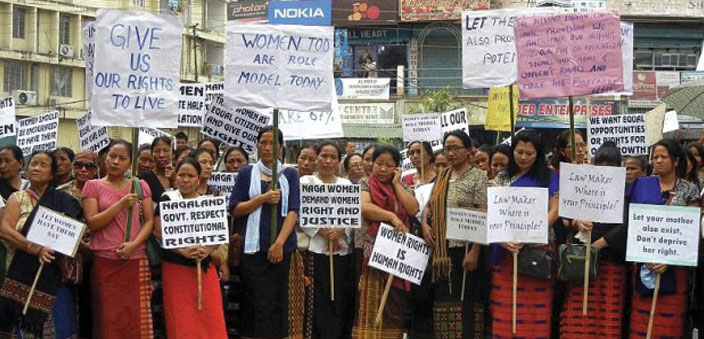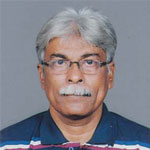Traditionally, the Northeast has been a disturbed area. There have been numerous separatists movements, some ended when a separate state was granted to them. Some, like Bodos, are still demanding a separate state of Bodoland. In other words, this region is known for some kind of trouble or the other. But now, Nagaland is facing a completely different problem, which is quite unique in the history of the Northeast.
There are riots that are playing havoc in Kohima, capital of Nagaland, and other cities where elections to Urban Local Bodies (ULBs) were scheduled to be held on 1 February 2017. Various tribal organisations began opposing not these elections, but the 33% reservation for women. The tribal bodies have formed a Joint Coordination Committee (JCC).
The genesis of the riots
The riots began on 31st January and such was its ferocity that the state government led by Chief Minister (CM) T.R. Zeliang was caught on the wrong foot, and the state cabinet decided to withhold these polls. Before these, there were various rounds of talks between the state government and the JCC, but they failed to yield any results. Consequently, on 28th January, the JCC called a district-wise bandh. On 31st January there were violent clashes in Dimapur and Longleng where two people were killed and many injured. On 1st February, violence broke out in Mokokchung district. The district office of ruling Naga People’s Front (NPF) was attacked and the office of the Election Commission was ransacked. Then came the refusal by the protesters to bury the bodies of those killed in the 31st January incident, unless the chief minister and other ministers resigned.
This is the sequence of events and it was necessary to put all these details in perspective to understand the gravity of the situation. It is not one of those riots which erupt regularly in some part or the other of Northeast. It is an extremely unusual situation where the Nagas are asking for the repeal of the constitutional provision providing women a minimum of 33% reservations in the Panchayati Raj Institutions (PRI).
It is also necessary to recall that these reservations were put in place by the Narasimha Rao government when it got passed the 73rd and 74th amendment, which in turn gave a minimum of 33% reservations to women in rural as well as urban local bodies. It was expected that these constitutional provisions would be applicable to the entire country. Now it seems that the Nagas are not willing to implement this in their state. Hence, the violent agitations.
Politics at play?
There is an angle of party politics to this issue as well. Today, Nagaland is ruled by Naga People’s Front (NPF)-led Democratic Alliance of Nagaland (DAN) in which BJP is also an ally. Nagaland has an assembly with maximum 60 MLAs. Though the ruling alliance enjoys solid support in the Assembly, the latest riots have created fissures in the DAN. A large number of legislators of the ruling NPF are challenging the leadership of Zeliang. It is rumoured that nearly 20 MLAs are in touch with Neiphu Rio, former chief minister of Nagaland and currently an MP.
The Nagaland Tribes Action Committee (NTAC) has asked for the CM’s resignation and thereby wants to nullify the urban local body polls. The protest in Nagaland started after the state assembly on 24 November 2016 revoked its earlier resolution of 22 September 2012, which proposed a wider consultation with Naga civil society before adopting a Central legislation (Article 234 T) giving 33% reservation to women in PRI elections. But the government of Zeliang wanted to proceed with the elections to urban local bodies.
Regions accorded special status
We often read about Article 370 that grants special status to Jammu and Kashmir. But in our Constitution there are numerous articles which grant special status to many states of the Indian Union. For example, Article 371 gives Vidarbha, Marathawada of Maharashtra and Kutch, Saurashtra of Gujarat a special status. There are many such articles beginning from 371 (a) to 371. (J). These are grouped together in Part XXI. In the latest violence in Nagaland, we find article 371 (A) in discussion, which gives Nagaland a special status. This article is meant to maintain the special way of life of the Nagas. This is why it provides that if the Indian Parliament makes any law that affects the Naga’s customary life, it will not be applicable till such law is ratified by the Assembly of Nagaland. This is why the agitators are now asking for using Article 371 (A) to ensure that the 33% reservation given to women in PRI bodies does not become applicable to Nagaland.
The Article 371 (A) that Nagas wear as a badge of pride, states: ‘Notwithstanding anything in this constitution, no Act of Parliament in respect of religious or social practices of the Nagas, Naga customary law and procedure, administration of civil and criminal justice involving decisions according to Naga customary law, ownership and transfer of land and resources, shall apply to the state of Nagaland unless the legislative assembly of Nagaland by a resolution so decides.’ Using the Article 371 (A) as a shield, now Nagas are demanding that 33% reservations to women should not be applicable to Nagaland. Traditionally, women in Naga society have not enjoyed any right over land, nor do they have much voice in the village councils – the core of Naga society – where men have been the ones to exercise control and take decisions.
If 33% reservation is allowed for women in the PRIs bodies, men fear that they will control precious resources like land and money. Many Naga men feel this would violate customs and its effect could percolate to the villages, which in turn could upset how Naga society has functioned for centuries, with men being in control and women remaining in the shadow. Men are also busy pressuring bodies like Naga Mothers Association (NMA) which have been fighting for gender rights and justice. Consequently, many ordinary Naga women have moved away from the NMA.
Unconstitutional demand?
It must be mentioned upfront that the demand not to allow women reservations in PRI bodies is out and out unconstitutional. What is more worrisome is the fact that the Nagaland government has decided to write to the Centre demanding that Nagaland be exempted from Part IX A of the Constitution. This shows that the state government is playing the role of the biblical Pontius Pilate by washing its hands off the reservation issue, and sacrificing the rights of Naga women at the altar of Naga males’ tribal ego. If the demand of the NTAC is accepted, the Naga women will have absolutely no hope of entering into and participating in decision-making bodies.
A careful reading of today’s India reveals that at the core is the clash between tradition and modernity. As with Jallikattu in Tamil Nadu, tradition and local customs are the ruse in Nagaland. The protesters in Chennai argued that Jallikattu was their proud tradition and wanted the practice to continue. In Nagaland, men say women played no part in state’s politics and that it should stay that way. In a traditional society like India, this is bound to happen. There is where the role of the state comes into the picture. Remember Lord William Bentinck? He took the initiative and passed the anti-Sati law in 1829. Though some progressive Indians like Raja Ram Mohan Roy had campaigned for this, basically it was an initiative of Lord Bentinck. He did not have to worry about public opinion and vote banks. In democratic polity like ours, such decisions have to be taken quite sensitively. But the state cannot abdicate its responsibility towards progressive agenda. Nagaland is likely to be a test-case for the Modi government.


 [/column]
[/column]